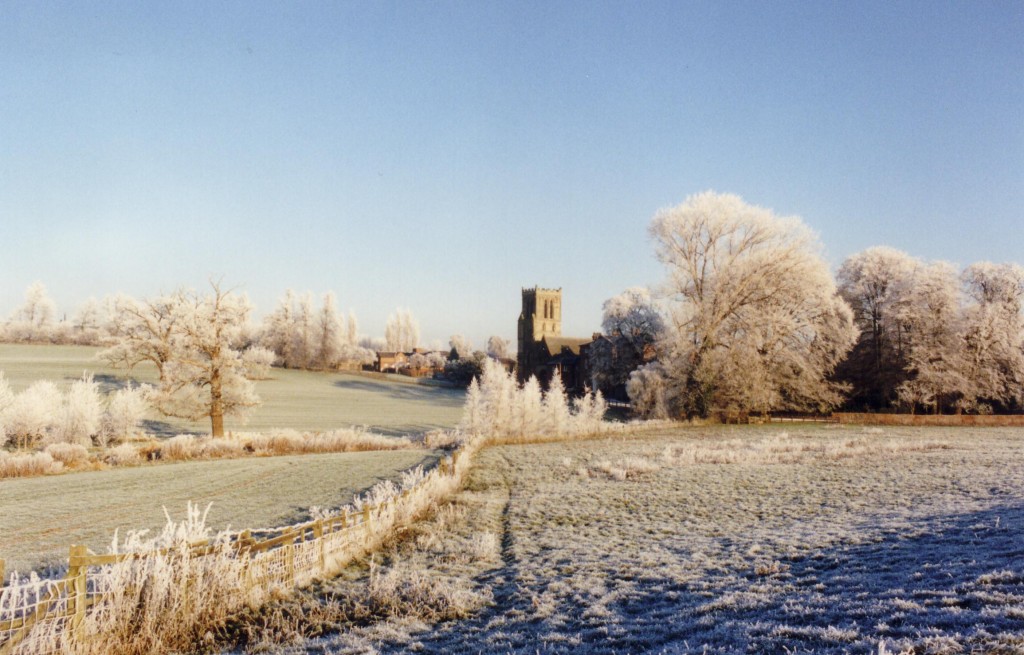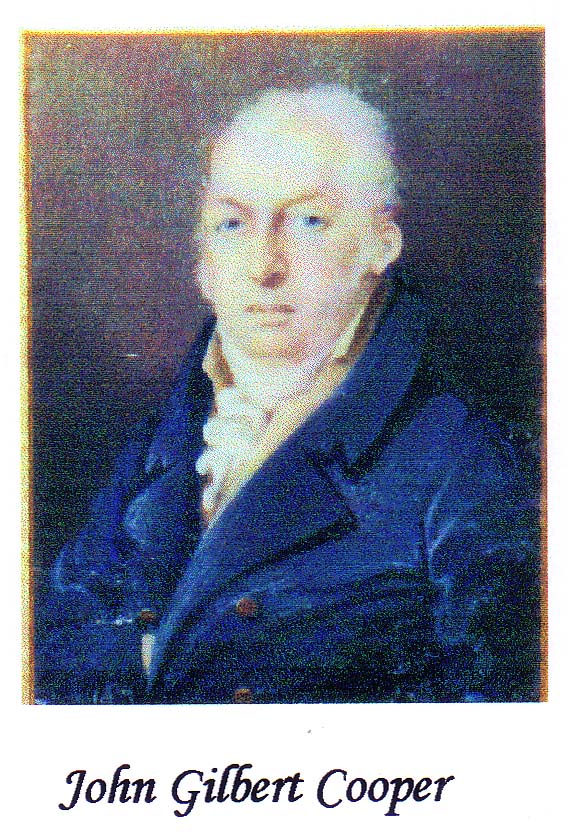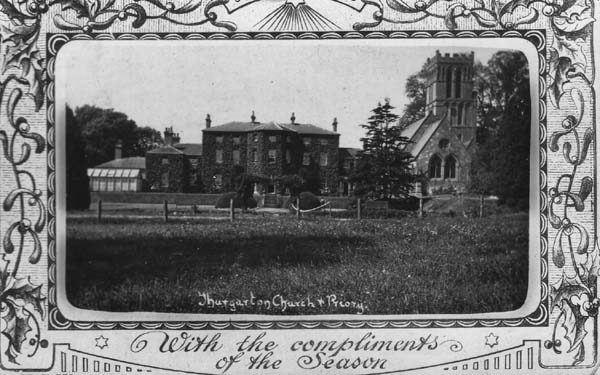In 1820 Col. John Gilbert Cooper Gardiner sold the Thurgarton estate which had been in his family since the supression of the Priory in 1538. His great grandson, Lt. Cecil Gilbert Cooper R.N. visited Thurgarton in 1869. The young man described his visit in a letter to his father before leaving England to serve on HMS Glasgow the flagship of the British East Indies fleet in 1871/2. In 1873/4 he transferred to HMS Vulture which patrolled the east coast of Africa on anti- slavery duties. His sister, a Mrs Benson of Bray, Berks sent a copy of her brother’s letter to the Reddan family who lived at Thurgarton Priory in the 1930s :-
Here is a copy of my brother Cecil’s letter written to my father about his one and only visit to Thurgarton in 1869. It was my brother’s ambition, if and when Thurgarton was in the market again, to be able to buy it back, but alas he died 5 years after his visit to Thurgarton aged 22 yrs from an East African fever caught whilst pursuing slave dhows. He was a very brilliant young fellow who had won 3 first classes in the Navy examinations and was sent for to the Admiralty and congratulated.
Copy of portions of a letter written by Lt. Cecil Gilbert Cooper RN to his father, the Rev. William Wright Gilbert Cooper describing his visit to Thurgarton in August 1869.
Having heard my father speak of Thurgarton Priory with much interest as an estate which not very long ago belonged to our family, I was very desirous not to leave England again without seeing it and to gratify my curiosity. We arrived in Thurgarton station at 11.30 and were on the look out for the first glimpses of the village – we were pleased beyond our expectations. Lying between two hills, beautifully wooded with lofty and ancient trees with every here and there a cottage showing and glimpses of the old tower of Thurgarton church peeping out between the trees on the side of the hill – it was a most peaceful scene worthy and characteristic of dear old England.
Thurgarton church tower amongst the trees on a frosty morning 1996
As we stepped out of the train an elderly gentleman with a white beard and moustache got in. When the train started we enquired who he was and were told it was Mr Milward. We rather regretted not being able to make his acquaintance for we had heard that he was a very good-natured sort of man. ( Note The Milwards had bought the Thurgarton estate from the Coopers in 1820).
By this time it was nearly 12 o’clock and we , not having had anything since 6.30 felt that a little luncheon would not be amiss. We left the station and walking some way down a road and turned left through the village . There were cottages all along the road , clean looking and well kept, with a nice garden in front, here and there a stately tree; the fields being small with numerous hedges giving the country around a very wooded appearance. Opposite to the gate to the carriage road of the Priory stood a newly built school which one of the villagers told us had been built by Mr Milward. Thurgarton is , I think, in a very nice situation- it is less than 3 miles from Southwell, about 10 miles from Newark ; they get the papers from London every day at about 1 o’clock and can get there comfortably in four hours.
We found the village Inn to be the ‘White Hart’ ( a very common name in these parts) and made ourselves very comfortable in the little old parlour where we made a very good luncheon of cold lamb. ( Note The inn is now The Coach and Horses)
The woman who kept the Inn had only been there for a short time and could not give us much information but told me that the Parish consisted of about 4,000 acres, 1500 of which belonged to Trinity College Cambridge together with the presentation of the church, and the remaining 2000 acres originally part of the Priory estate was now owned by Mr Cane a gentleman of property in the neighbourhood. ‘’ However the parish clerk’ she said, ‘ lives next door and could tell you everything you could wish to know about the church and Priory’.We started from the Inn at 12.30 and went to the old clerk’s house and found him and his wife at dinner. We got from him the keys of the church and bade him follow as soon as he could.
We walked down through the churchyard and went into the church through the north entrance. The first thing that I saw were several tablets bearing the name Gilbet-Cooper over the church door. The largest central one was of white and grey marble to John Gilbert Cooper and Susannah his wife; the former died in 1803. On the left to John Gilbert Cooper Gardiner who died 18th August 1822, who I think was my great grandfather, and his wife Catherine who died 14th June 1806. The one beneath is to Dorothea their daughter. The upper tablet on the right is to Susanna Wright Gilbert Cooper erected by her niece Josephine Lysons. The one beneath is to Lt-Col Henry Gilbert Cooper erected by the Rev. Daniel Lysons.
The Cooper memorials Thurgarton church
Whilst we were looking at the tablets the parish clerk came in and on my telling him my name , he became much interested and asked me if my name was Cecil? I answered in the affirmative. ‘Well Sir’ he said, ‘ that is very curious for my ancestors came into this parish with yours as servants of the family. Your ancestor’s name was Cecil and my father has often told me that all our family have been named after him; my name is Cecil , my father’s was and his father before him. We were all servants of the family and when the last Gilbert Cooper left Thurgarton I became Parish Clerk.
After this he evidently took great pleasure in showing us over the church. I could not get much from him about the last of our family who lived at Thurgarton. He said the money seemed to go and nothing to show for it, that they were good easy people , very hospitable and much liked by rich and poor. The church is of the Early English style with pointed arches and carved pillars. The whole was restored about 1860 almost entirely at Mr Milward’s expense. It must have been about this time that the family vault was sealed and the family tablets removed from the chancel to their present position over the northern entrance. The clerk showed us the position of the family vaults which was on the left of the pulpit in front of the chancel steps.
The altar cloth and carpet for the chancel was entirely worked by Mrs Milward and Mr Milward gave at the same time a nice little organ.The seats in the chancel are of very old date and move on hinges , having carved underneath curious representations of friars, evil spirits,etc.
One of the most remarkable things in the church was an ancient picture on the north side of the chancel of The Holy Family. The clerk told me it was a painting by Raphael. We asked him how long it had been there? ‘As long as he could remember’ he said and ‘that his father had told him that it had been given by the Coopers many years ago’. My uncle and I were incredulous that this could be a genuine Raphael. ( Note The painting is a mirror image copy of The Holy Family of Francis 1 by Raphael which now hangs in the Louvre).
The Holy Family of Francis 1 by Raphael
We bade the old clerk, Cecil Richardson, good day – it was nice that the old man had such a warm recollection of the family. We walked to The Priory and knocked on the hall door, and giving our cards to the butler and said for what purpose we had come to Thurgarton and that we would be much obliged to Mrs Milward if she would kindly permit us to see the old parts of the Priory. She kindly told the butler to show us all over the house and offered us luncheon, which we declined. The butler led the way into the dining-room where to our astonishment we came upon a life sized painting of the same man as seen in a miniature kept by my Grandmother in her drawing-room in London ( left to her by my late great aunt Mrs Lysons). I immediately asked the butler who it represented? He said it was Colonel Cooper and the picture on the opposite side his wife. Mr Milward had found them in a back room covered in dust and had them cleaned and put up. He heard they were much prized and had been handed down through many generations of the family.
John Gilbert-Cooper
The dining room has a good look out over the lawn and is very tastefully furnished including a beautiful old sideboard having a date 1659 and the drawing room is a beautiful room with a bow out from the centre of the house. The next room on the left is the library where Mr Milward as Magistrate dispenses justice to delinquents doubtless in the same position occupied by the Coopers for several generations. Having seen the old servants hall ( Mr Milward has built a new one) and kitchen we descended to the cellars which are the remains of the Priory as before the Reformation.
The ceiling is curiously groined in arches rising from pillars like leaves from palm trees. The cellars were very capacious and certainly if the monks kept them anything like filled they must have lived in luxury. At the extreme end of the cellar was a small door very solid and strongly bound with iron which we were told was the entrance to a subterranean passage communicating with Horton Abbey – a distance of 3 miles.
( Note As in so many parishes stories of underground passages abound in Thurgarton. This version was said to have linked Thurgaton Priory with a nunnery at Halloughton 3 miles away. There was no such nunnery but a mediaeval prebendary house at Halloughton and a 3 mile passage under rolling hills would have been an engineering feat on a par with today’s Channel Tunnel)
The butler told us that during the church restoration the men engaged with the drainage and heating of the church were continually coming upon foundations of the church and priory – ‘ they must have been of a very large dimensions, more than twice or three times the present size’. He showed us some coloured tiles which had been dug up and said by competent persons to be 3-400 tears old. We could make out the carving of a coat of arms with something like a fleur-de-lys in a shield which resembles the Cooper arms.
The house is of red brick and had it not been thickly covered with ivy would I think be ugly. The butler told us that it had been built about 100 yrs ago and old people in the village had recalled the building of the garden wall. He said the house was not a new one for it was built of the old stone of the Priory but it was modernised and faced with red brick. It is a great pity that it should have happened at that time when taste seemed to have left the world – for from its size and dimensions and the beauty of the adjoining church , it must have been a splendid building. The lawns and gardens are very beautifully laid out. We took our departure when I had taken a rough sketch of the Priory and Church and so we turned our backs on it – to a feeling of regret on my part. ( Note The Georgian house of brick was newly built in 1770s and replaced a stone Tudor house . Both house are built over the cellars or undercroft, the surviving ground floor of the west range of Thurgarton Priory).
Thurgarton Priory c 1930 clad in Ivy.
PS My grandmother Mrs Gilbert Cooper when I showed her the sketch of Thurgarton, told me it brought back to her the times she had stayed there when Col. Cooper Gardiner owned it. She told me that there were three (trees) that stood on the left of the house called the ‘Three Sisters’, that the dining room was the lower room of the bow, the drawing room was on the second floor of the bow and that the top room on the right was said to be haunted and was closed up and never used and that the servants were much afraid of going near it.
My grandmother described my late great uncle Col Cooper Gardiner as the most perfect gentleman. She always thought he kept company above his means – that is ; William and his Queen were often there , that the Dukes of Newcastle and Beaufort and various other noblemen were constantly staying with him. She said that Col. Cooper Gardiner had taken my uncle Henry Gilbert Cooper under his care and had declared it his intention to leave the Thurgarton estate to him.
Col. Cooper Gardiner stood for the County of Nottingham , in the Radical interest, and was constantly going about at that time associating with working men and that through this suffered ill health and combined with the loss of Thurgarton, which he was obliged to sell – the mortgages being foreclosed by Mr Milward , the son of his father’s coachman of whom he had borrowed money to stand for the county in which he failed – all brought on the illness from which he died, broken hearted by the thought of having, by his folly, lost the Thurgarton estate which had been for so many years in the family. He was buried at Rodmorton in Gloucestershire in the Lyson’s vault.
My great aunt Mrs Lysons, was left sole executor by his will but she was in great distress owing to the death of her daughter –in-law and so did not go herself to Thurgarton and so many family pictures and curiosities were lost to the family. PS The family portraits were most kindly returned to us by Mr Milward who would not even let us pay for their carriage.







I was fascinated to read the letter as I have just come across an old note book about my parents’ visit to Thurgaton in 1962. My mother was the last of the Gilbert-Cooper family ( the name died out with her Uncle Everard). She donated some life-sized family portraits to Nottingham Public Library as it was known then. One of these was in our house for quite a time until it, too, was donated. I am trying to discover how many she donated and who they were. The photo in your letter is somehow familiar to me but as I was a child at that time I cannot be certain. She also mentioned the supposed Raphael and I was glad to read it’s true identity.
I would enjoy being able to learn more about my ancestors, my mother died in 1999 and all I have is a painting of Thurgaton Priory and some old photos, possibly of those portraits.
Yours faithfully,
Susan Cooper
revdsusancooper@gamil.com
20/24 Hall Rd. Ngongotaha, Rotoura. NZ
Hello Susan
The Coopers bought Thurgarton Priory from the crown during Henry 8th reign together with half the parish of Thurgarton. Most of the Priory including the church was demolished leaving a small remnant as the parish church next to which the Coopers built a Tudor mansion. The family ( Cooper then Gilbert-Cooper then Gilbert- Gardner – Cooper) lived there up to the early 19th century when they sold the estate. They figure in some of the other articles on the website especially the one on the Civil War.
I may be mistaken but I think some family portraits are held at Nottingham County Archives nowadays run by a company called Inspire.
Hope this is of interest
Best Wishes
Ellis .